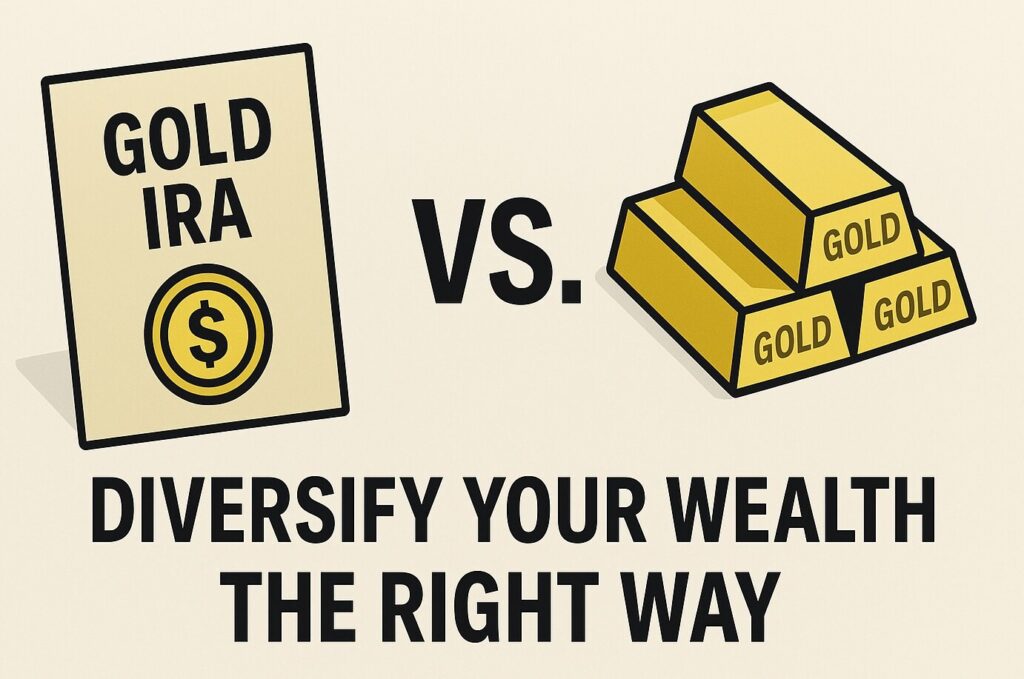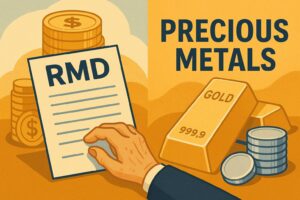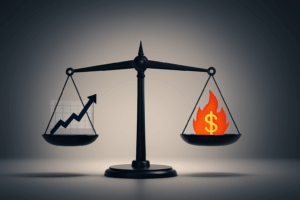
Gold IRA vs Physical Gold Investment is a crucial consideration for anyone seeking stability in today’s economically uncertain world. As precious metals maintain their reputation as safe-haven assets, investors increasingly turn to gold to diversify beyond traditional stocks and bonds. However, how you choose to invest in gold can make all the difference. Whether through a Gold IRA or direct physical gold ownership, each strategy comes with unique benefits and key factors to weigh before making a move.
Understanding the Fundamental Differences
When comparing Gold IRA vs Physical Gold Investment, the key difference lies in ownership and storage. A Gold IRA (Individual Retirement Account) is a self-directed retirement account that holds physical precious metals in a secure, IRS-approved depository on your behalf. On the other hand, direct physical gold ownership means purchasing gold coins, bars, or rounds that you personally possess and store, giving you full control over your assets.
“The key differences between these investment vehicles extend beyond mere possession,” notes financial advisor Marc Stevens. “They fundamentally differ in their tax treatment, storage requirements, liquidity options, and overall investment objectives.”
Tax Advantages: A Critical Consideration
One of the most significant advantages of a Gold IRA is its tax benefits. Like traditional IRAs, contributions to a Gold IRA may be tax-deductible, and the investments grow tax-deferred until retirement. For those with existing retirement accounts, a gold IRA retirement strategy might involve rolling over funds from a 401(k) or traditional IRA into a precious metals IRA without incurring immediate tax consequences.
According to a recent Yahoo Finance report, “The tax advantages of Gold IRAs make them particularly attractive for investors with a long-term horizon who want to incorporate precious metals into their retirement planning.”
Physical gold, by comparison, offers fewer tax advantages during the acquisition phase but may have different capital gains tax implications when sold. Gold coins and bullion are considered collectibles by the IRS and may be subject to a maximum capital gains tax rate of 28%, compared to the lower long-term capital gains rates that apply to many other investments.
Security and Storage: Protecting Your Investment
The security of your gold investment presents another key differentiator between these options.
With a Gold IRA, approved depositories handle secure storage, typically offering allocated storage where your specific metals are segregated from others. These facilities provide professional security, insurance, and regular auditing — eliminating personal security concerns but adding annual fees to your investment costs.
Physical gold ownership gives you complete control over your investment but requires you to solve the storage dilemma yourself. Home storage introduces security risks, while bank safe deposit boxes have limitations regarding access and insurance.
The Commodity Futures Trading Commission (CFTC) advises investors to “thoroughly investigate the security measures and insurance coverage of any storage solution you consider for physical precious metals.”
Costs and Fees: Understanding the Total Investment
Cost structures differ significantly between these investment approaches:
Gold IRA Costs:
- Setup fees ($50-$150)
- Annual maintenance fees ($75-$300)
- Storage fees (typically 0.5%-1% of assets annually)
- Custodian fees
- Potential buy/sell spreads when acquiring or liquidating metals
Physical Gold Ownership Costs:
- Premium over spot price (varies by product type, typically 3%-10%)
- Potential sales tax in some jurisdictions
- Storage costs (safe, safe deposit box, or private vault)
- Insurance expenses
- Potential dealer buy/sell spreads when acquiring or liquidating
“When comparing costs, investors should consider the total expense ratio over their expected holding period,” recommends Diversify Guy. “For longer-term holdings, the annual fees of a Gold IRA can compound and potentially outweigh the one-time premium costs of physical gold.”
Get Gold & Silver Insights Direct to Your Inbox
Join thousands of smart investors who receive expert analysis, market updates, and exclusive deals every week.
Liquidity Considerations: Access to Your Investment
How quickly and efficiently you can convert your gold back to cash when needed is another important factor.
Gold IRAs have specific rules regarding distributions. Taking possession of the metals before age 59½ typically incurs a 10% early withdrawal penalty plus applicable taxes. This structure inherently discourages short-term trading or accessing your metals during temporary market fluctuations.
Physical gold offers immediate liquidity—you can sell your metals to dealers at any time without age-related penalties. However, during market disruptions, finding a buyer at favorable prices may become challenging, as noted in a BP Trends analysis: “While physical gold provides greater access flexibility, actual liquidity may vary significantly based on market conditions and the specific products you own.”
Investment Strategies: Matching Method to Goals
Your investment objectives should ultimately drive your decision between these options.
A Gold IRA typically suits investors with a long-term retirement focus who value tax advantages and professional security over immediate access. As detailed in our precious metals IRA guide, these accounts work best as part of a diversified retirement strategy rather than a short-term tactical position.
Physical gold ownership appeals to investors seeking direct control over their assets, those concerned about counterparty risk in the financial system, or individuals wanting the flexibility to access their precious metals without institutional barriers. For many investors, investing in physical metals provides peace of mind during periods of market volatility.
Making the Right Choice for Your Portfolio
The gold investment vehicle that best serves your needs depends on your specific circumstances:
Consider a Gold IRA if:
- Tax advantages are a priority
- You’re investing primarily for retirement
- Professional storage gives you peace of mind
- You prefer a hands-off approach to security
- You have existing retirement funds to roll over
Consider physical gold if:
- Direct control over assets is paramount
- You desire immediate access to your investment
- You’re concerned about systemic financial risks
- You want to avoid annual fees and administrator dependency
- You have secure storage solutions available
As CBS News reports, “Many sophisticated investors ultimately incorporate both approaches—using Gold IRAs for retirement planning while maintaining some physical metals for liquidity and direct control.”

The Silver Investment Opportunity Gold Investors Are Missing
Discover why silver may be the smarter investment opportunity now, offering greater growth potential than gold.
Read MoreDiversification Within Your Diversification
Remember that gold itself is primarily a diversification tool within your broader investment strategy. Historical performance data from the past decade shows that both gold and silver have delivered significant returns during periods of economic uncertainty, with gold demonstrating more stability and silver offering higher volatility and potential returns.
For many investors, the answer isn’t either/or but rather determining the appropriate allocation between different precious metals investment vehicles based on their overall financial plan.
Conclusion: Creating a Balanced Approach
When evaluating Gold IRA vs Physical Gold Investment, it’s clear that both options offer unique benefits when strategically included in your investment plan. By understanding the strengths and limitations of each, you can build a precious metals portfolio that not only boosts your overall financial resilience but also aligns with your personal goals and risk tolerance.
Before deciding between a Gold IRA vs Physical Gold Investment, it’s wise to consult with financial professionals experienced in precious metals. Their guidance can help ensure your chosen strategy fits seamlessly within your broader wealth management plan. No matter which option you select, incorporating gold into your portfolio offers a proven hedge against economic uncertainty and currency devaluation—benefits that few other assets can rival.
Investing in Physical Metals Made Easy
Open an AccountNote: This article is provided for informational purposes only and should not be considered investment advice. Always conduct thorough research or consult with qualified financial professionals before making investment decisions.






![Is Now the Best Time to Buy Silver? [Silver 2025–2030 Forecasts]](https://goldsilver.com/wp-content/uploads/2025/11/price-of-silver-300x155.jpg)





